Last updated on March 8th, 2024 at 04:59 am
Peace lilies, renowned for their elegant white blooms and vibrant green foliage, not only enhance the beauty of indoor spaces but also serve as effective air purifiers. These versatile plants are well-suited for enthusiasts of all levels, thanks to their straightforward requirements for the care of a peace lily. In this guide, we’ll delve into the fundamental aspects of peace lily care, ensuring your plant thrives and brings a sense of tranquility to your home.
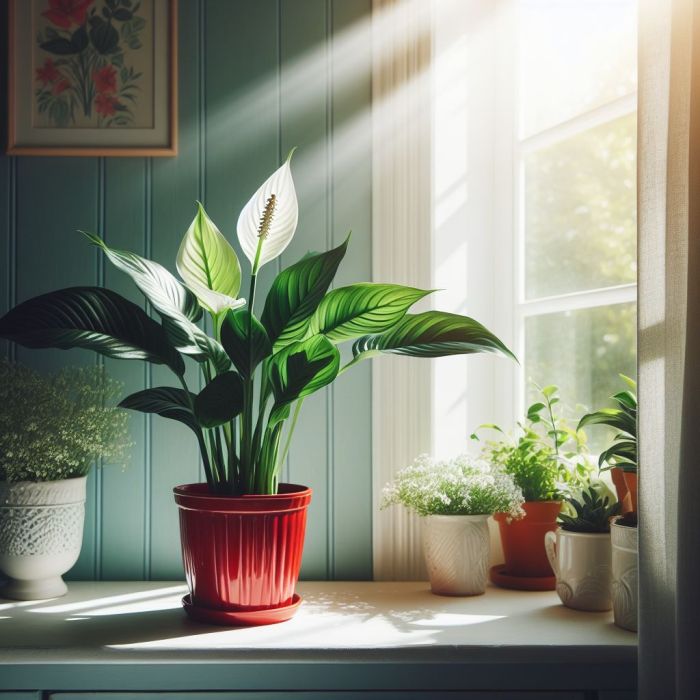
Peace lilies, characterized by glossy dark green leaves and delicate white flowers known as spathes, have maintained their popularity as cherished houseplants. According to horticulturist Justin Hancock of Costa Farms, with proper care, a peace lily can live for a decade or more. Ensuring proper care of a peace lily is essential for its longevity. While they can tolerate low and medium light conditions, these plants truly thrive in bright light, leading to faster growth and increased blooming.
Most peace lilies typically grow to a width of one to four feet, with some varieties reaching heights and widths of up to six feet. These plants prefer average indoor temperatures, ideally ranging between 65 to 85 degrees Fahrenheit. Additionally, peace lilies are not only aesthetically pleasing but also budget-friendly, making them widely accessible for plant enthusiasts.
Contents
- 1 Tips For The Care Of A Peace Lily
- 1.1 Lighting and Placement:
- 1.2 Proper Watering For the Care Of Peace Lily
- 1.3 Importance of Humidity for The Care Of A Peace Lily:
- 1.4 Choosing the Ideal Soil Mix For The Care Of A Peace Lily
- 1.5 Repotting For The Care Of A Peace Lily
- 1.6 Fertilizing For The Care Of A Peace Lily
- 1.7 Pruning in Peace Lily Care
- 1.8 Pest Control for a Thriving Peace Lily
- 2 FAQs
- 3 Author
Tips For The Care Of A Peace Lily
Now, let’s explore the essential tips for the care of a peace lily that contribute to the well-being of your peace lily and ensure it becomes a flourishing centerpiece in your indoor oasis.
Lighting and Placement:
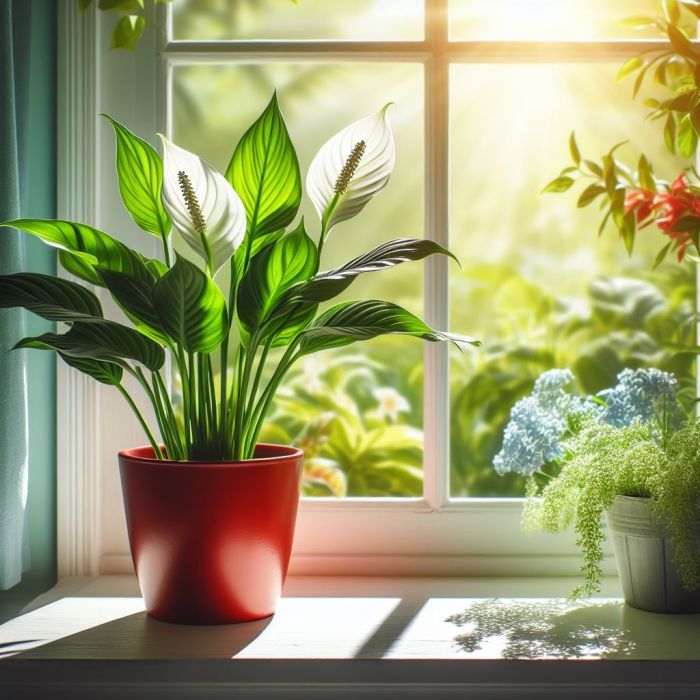
Central to the care of a Peace Lily is providing them with the right lighting conditions. These plants exhibit a preference for bright, indirect light, although they can adapt to lower light levels. Striking a balance is key – while Peace lilies can tolerate low and medium light, they truly thrive in bright environments. Positioning your Peace lily near a north or west-facing window, where it can receive filtered sunlight, ensures it enjoys the perfect blend of brightness without the risk of leaf scorching. Monitoring and adjusting the light exposure will contribute significantly to the plant’s happiness, growth rate, and blooming potential.
Size, Temperature, and Affordability
Peace lilies are known for their attractive dark green leaves and elegant white spathes, creating a visually appealing addition to any indoor space. These plants typically grow to a width of one to four feet, with certain varieties reaching impressive heights and widths of up to six feet. Beyond their aesthetic appeal, Peace lilies are low-maintenance and budget-friendly, making them accessible to plant enthusiasts of all levels. In terms of temperature preferences, they thrive in average indoor temperatures ranging between 65 to 85 degrees Fahrenheit. Their adaptability and cost-effectiveness make Peace lilies a popular choice for those seeking an enduring and economical plant companion.
Proper Watering For the Care Of Peace Lily
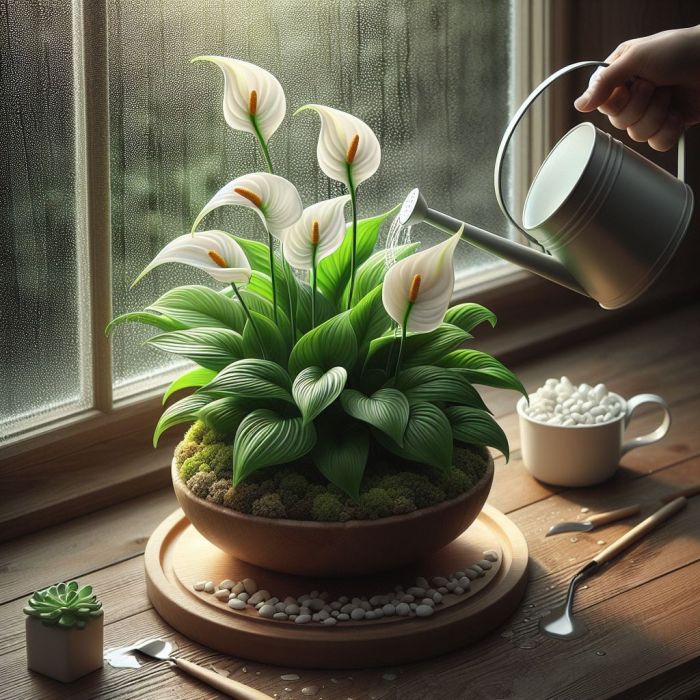
Certainly! In the care of a Peace lily, proper watering is a fundamental aspect to ensure the plant’s well-being. Maintaining the right balance of soil moisture is crucial for their growth and health. Peace lilies prefer consistently moist soil, but it’s essential to avoid overwatering, which can lead to soggy conditions. To gauge when to water, simply check the top inch of the soil – if it feels dry to the touch, it’s time to water.
If you notice the leaves starting to droop, it’s an indication that your Peace lily is thirsty and in need of hydration. This visual signal is a helpful prompt to adjust your watering routine. During the dormant winter months, it’s advisable to reduce the frequency of watering. However, even in this period, it’s essential to maintain a slightly moist environment to prevent the soil from drying out completely. Striking the right balance in watering practices ensures your Peace lily remains healthy and vibrant, and continues to thrive throughout the changing seasons.
Importance of Humidity for The Care Of A Peace Lily:

Peace lilies really like humidity, and it’s important to take care of them. To make them happy, put them in spots that are naturally more humid, like bathrooms or kitchens. These places are perfect for peace lilies to grow well.
Combatting Low Humidity
If your home tends to have lower humidity levels, fear not—there are effective solutions to create the perfect microclimate for the care of a peace lily. Investing in a humidifier is a practical and direct approach, infusing the air with the moisture that these plants crave. Additionally, placing a tray filled with water and pebbles near the plant serves as a simple yet efficient method to increase ambient humidity.
Misting for Microclimate
An accessible and hands-on technique to enhance humidity around your peace lily is regular leaf misting. Gently misting the leaves at regular intervals mimics the tropical conditions in peace lilies naturally thrive. This proactive measure ensures your plant receives the moisture it requires, promoting not only aesthetic appeal but also overall health and vitality. By understanding and addressing the humidity needs of your peace lily, you’re setting the stage for a lush and thriving indoor oasis.
Choosing the Ideal Soil Mix For The Care Of A Peace Lily

In the care of a peace lily, the choice of soil is a critical determinant of their overall health and vitality. Opt for a well-draining, peat-based potting mix to provide the perfect foundation for your peace lily. This specialized blend serves two crucial purposes: preventing waterlogging and promoting aeration. The well-draining nature ensures that excess water doesn’t accumulate in the soil, safeguarding the roots from potential damage caused by overly soggy conditions. Simultaneously, the peat-based composition contributes to a light and airy texture, facilitating optimal airflow to the roots.
Healthy roots are the cornerstone of a thriving peace lily, and the chosen soil mix plays a pivotal role in maintaining their well-being. The aeration facilitated by the peat-based mix allows the roots to access oxygen efficiently. This not only aids in nutrient absorption but also prevents the onset of root rot—a common issue in poorly aerated or waterlogged soils. By prioritizing a well-draining, peat-based potting mix, you’re proactively contributing to the long-term vitality of your peace lily.
Repotting For The Care Of A Peace Lily

As your peace lily grows and matures, it’s essential to be attentive to its container size. Repotting every 1-2 years or when you observe the plant outgrowing its current container is a key aspect of its care routine. This practice not only provides the plant with fresh, nutrient-rich soil but also ensures ample space for root expansion. Repotting is an opportunity to inspect the roots, remove any diseased portions, and rejuvenate the overall health of your peace lily, promoting continuous growth and flourishing.
Fertilizing For The Care Of A Peace Lily
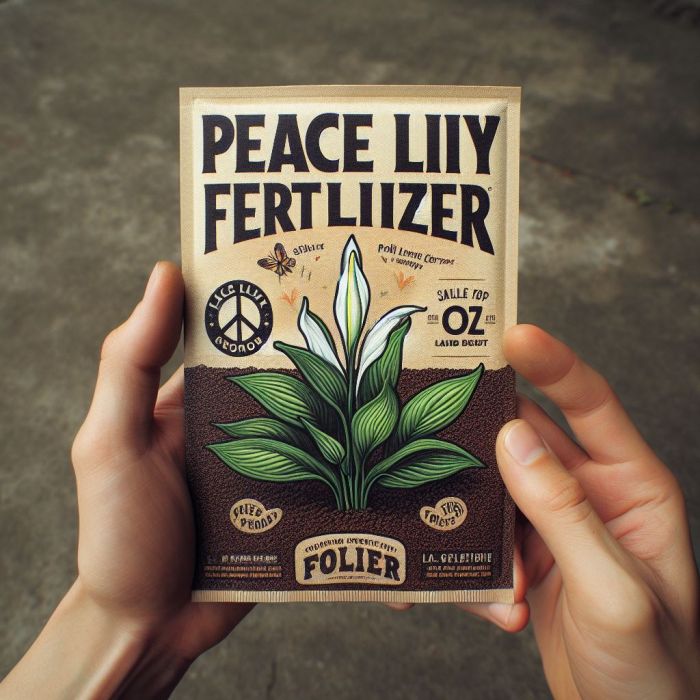
Fertilizing is a key component in the care of a peace lily, playing a crucial role in supporting its growth and promoting vibrant blooms. During the active growing season, typically in spring and summer, it is essential to regularly feed your peace lily. Opt for a balanced, liquid fertilizer, as it ensures a comprehensive range of nutrients for the plant’s overall health. However, a crucial tip is to dilute the fertilizer to half the recommended strength. This cautious approach prevents the risk of over-fertilization, providing a balanced and controlled nutrient supply that aligns with the peace lily’s requirements.
Winter Rest
Understanding the seasonal needs of your peace lily is crucial for its long-term well-being. As the plant enters its dormant phase during winter, proper care of a peace lily involves reducing or eliminating fertilization. It’s advisable because, during this period, the plant naturally slows down its growth, and excessive nutrients may lead to imbalances or stress.
By adjusting the fertilization schedule in tune with the plant’s natural rhythm, you’re giving it the proper care it needs during winter, allowing for rest while ensuring essential nutrients are available when growth resumes in the active season.
Promoting Robust Growth and Blooms
Taking good care of a lily includes giving it the right nutrients for strong growth and beautiful flowers. Make sure to use the correct fertilizer, dilute it properly, and adjust based on the season. This proper care of a peace lily ensures it becomes a vibrant and healthy indoor friend, showing off its full potential.
Pruning in Peace Lily Care
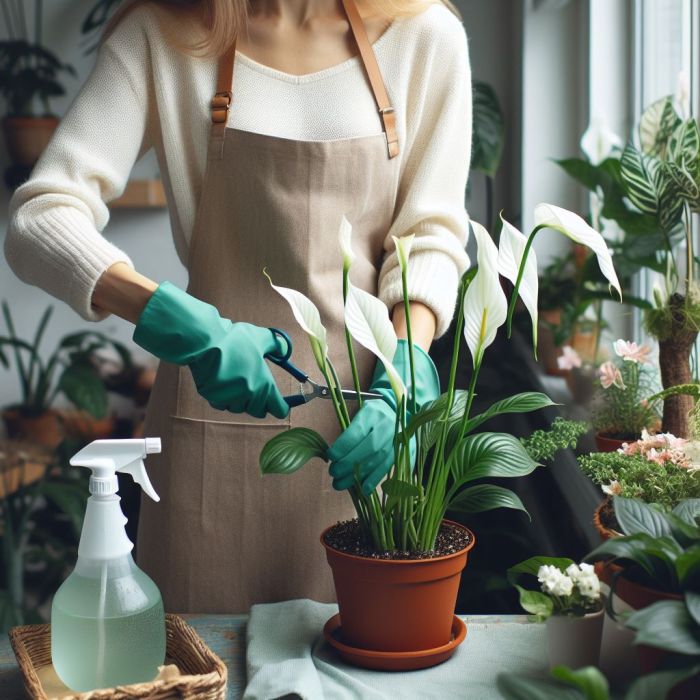
Pruning stands as a pivotal practice in the care of a peace lily, serving as a guardian of the plant’s overall health. When confronted with yellow or brown leaves, a swift response is essential. These discolored leaves not only diminish the plant’s visual allure but can also indicate potential stress or issues. By promptly removing these leaves, you redirect the plant’s resources towards areas of new growth. This proactive measure fosters an environment conducive to rejuvenation, ensuring the peace lily’s vitality and lush appearance.
Enhancing Blooms Through Flower Pruning
Pruning plays a dual role in the quest for vibrant blooms. When flowers begin to fade or wilt, delicately pruning them is not just a visual enhancement but a strategic move. The act of removing spent flowers communicates to the plant that it should channel its energy into producing new blooms. This not only maintains a tidy aesthetic but also encourages a continuous cycle of flowering. By participating in this delicate dance of removal and renewal, you’re ensuring your peace lily remains a dynamic and flourishing centerpiece in your indoor sanctuary.

Executing successful pruning involves a blend of precision and attentive care. Utilize clean, sharp scissors or pruning shears to make precise cuts, minimizing the risk of damage or infection. Regular inspections are paramount – keep a keen eye for any signs of yellowing or spent flowers, and act promptly. This meticulous and responsive approach to pruning is a cornerstone in the holistic care of your peace lily, contributing to its enduring health, visual appeal, and continuous cycle of growth and blooming.
Pest Control for a Thriving Peace Lily
To take good care of a peace lily, it’s important to watch out for pesky invaders. Bugs like spider mites and aphids can harm your plant. Check the leaves, stems, and undersides regularly for any signs of bugs. Proper care of the peace lily means catching these pests early and dealing with them quickly to keep your plant healthy and happy.
Should you detect any signs of pest infestation, timely and targeted treatment becomes crucial. Neem oil and insecticidal soap stand as effective allies in the battle against pests. These natural remedies offer a powerful yet gentle approach to pest control, minimizing the impact on your peace lily while effectively eradicating unwanted intruders. Application methods vary, but a cautious and thorough approach ensures that both the upper and lower leaf surfaces are adequately treated, leaving your peace lily pest-free and poised for continued health and vibrancy.
Incorporating pest control into your overall plant care routine is part of a holistic approach to keeping your peace lily thriving. Regular checks for pests, coupled with immediate and appropriate treatment when necessary, create a protective shield around your plant. This proactive stance not only safeguards the immediate health of your peace lily but contributes to its long-term resilience, ensuring it remains a resilient and flourishing presence in your indoor oasis.
FAQs
Can peace lilies thrive in low-light conditions?
Peace lilies are known for their adaptability and can tolerate low and medium light conditions. However, they truly thrive in bright, indirect light. Placing them near a north or west-facing window with filtered sunlight is ideal for optimal growth.
How often should I water my peace lily?
The frequency of watering depends on various factors such as environmental conditions and the growth stage of the plant. As a general rule, water your peace lily when the top inch of the soil feels dry. Adjust watering during the dormant winter months, reducing frequency while maintaining a slightly moist environment.
What is the best soil mix for peace lilies?
Peace lilies prefer a well-draining, peat-based potting mix. This type of soil prevents waterlogging and promotes aeration, essential for maintaining healthy roots. Repot your peace lily every 1-2 years using fresh, nutrient-rich soil to support its growth.
How do I encourage blooming in my peace lily?
To promote blooming, provide your peace lily with bright, indirect light. During the active growing season (spring and summer), feed it with a balanced, liquid fertilizer diluted to half the recommended strength. Regular pruning, removal of spent flowers, and proper care contribute to continuous blooming. What are common pests that affect peace lilies?
Common indoor plant pests for peace lilies include spider mites and aphids. Regularly inspect the leaves, stems, and undersides for signs of infestation. If pests are detected, treat the plant with natural remedies like neem oil or insecticidal soap.
How long can peace lilies live with proper care?
With proper care, peace lilies can live for a decade or more. Regular maintenance, appropriate lighting, watering, and other care practices contribute to the longevity and vibrancy of these plants.
In conclusion, caring for your peace lily involves a harmonious blend of attentive practices, from providing the right lighting and soil mix to maintaining proper watering and humidity levels. Regular pruning, vigilant pest control, and an understanding of the plant’s seasonal needs contribute to its enduring health and the continuous display of its elegant blooms. With these thoughtful measures, your peace lily becomes more than just a plant – it transforms into a resilient and vibrant companion, gracing your indoor space with tranquility and beauty for many years to come.

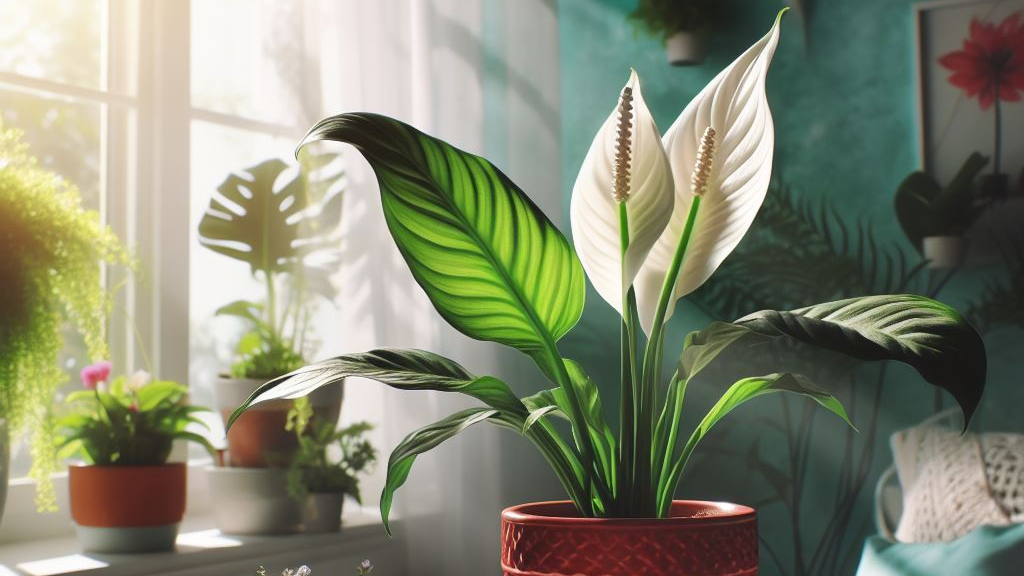
1 thought on “8 Tips For The Care of A Peace Lily for an Indoor Beauty”